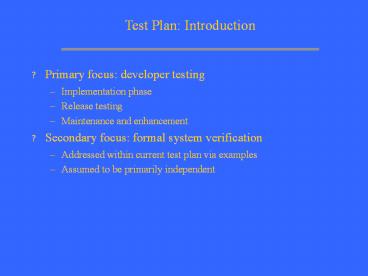Test Plan: Introduction - PowerPoint PPT Presentation
Title:
Test Plan: Introduction
Description:
Test Plan: Introduction Primary focus: developer testing Implementation phase Release testing Maintenance and enhancement Secondary focus: formal system verification – PowerPoint PPT presentation
Number of Views:210
Avg rating:3.0/5.0
Title: Test Plan: Introduction
1
Test Plan Introduction
- Primary focus developer testing
- Implementation phase
- Release testing
- Maintenance and enhancement
- Secondary focus formal system verification
- Addressed within current test plan via examples
- Assumed to be primarily independent
2
Tests to be Performed
- Bottom-up integration testing
- Build a module, build a test to simulate how it
is used - Black-box
- Based on specification and educated guess
stress tests - White-box
- Based on code inspection
- Platform testing
- Establish baseline capability of hardware/OS,
detect differences - Performance
- Per module, and peer to peer distributed costs
- Test coverage
- Coverage level dependent on resources, time, and
cost of failure
3
Allocation of Testing Responsibilities
- Assumption development team performs
- Internal (module-level) performance
- Sample system performance (limited example
federation) - Full white-box
- Limited black-box (basic system functionality)
- Assumption external group performs
- Independent, detailed system verification (Spec
compliant) - Standardized performance tests
- Test coverage
- Coverage will be measured, analyzed for relative
effectiveness - Coverage levels TBD
4
Testing Philosophy
- Testing is not just pre-release! Continual
process within development phase - Catch defects as early as possible
- Make sure defects stay fixed
- Track cause of defects repair problem, do not
keep re-patching the tire - Need support at both design level and
implementation level to accomplish these goals
5
Continual Testing Process
- Tests created during development
- Central code repository modules, test suites
tied together - Tests are treated as live code to be maintained,
not once-offs - Test documentation how to run, what is tested,
and why - Revision control on both modules and tests
- Modular development
- System broken down into hierarchies of testable
components - Automated, incremental integration testing
- As code is developed, it is tested standalone,
then incrementally within the confines of the
system - Continual feedback into development, maintenance
cycle - Weekly postings of performance results, current
defect status
6
Design Support
- Standard testing and debugging methods on each
module / class (peek, dump, exercise,
performance) - Self-checking code (pre and post parameter
asserts, valid state calls) - Debug levels, controlled via runtime flags
- Centralized logging mechanisms to collect
distributed traces - Logs used in both developer testing and sample
user traces from the field
7
Development Tool Support
- Shadow development trees for automated and
individual testing (ClearCase views) - Common testing tools, testing approach to
simplify testing process, and to allow automated
testing - Examples
- Standard test harnesses, method of invocation
- Standard testing directories, makefile commands
per module - Standard set of test-record-evaluate tools
- Central I/O mechanisms to collect distributed
test results - Standard system-level drivers
- Sequential test harnesses and emulated
distributed harnesses to emulate determinism
during development
8
Levels of Testing per Module
- Basic used in initial development, later in
porting - Minimal level of functionality to establish
module operation - Simplicity is critical during development,
porting - Detailed used to verify module correctness
before checking into current baseline - Does module meet interface contract
- Tests for common coding errors
- Regression replicates previous use which caused
failure - Used to verify defect has been corrected
- Used to ensure defect does not re-occur over time
- Performance tracks the CPU usage per module and
peer to peer performance across distributed
components
9
Complex Functional Areas Testing Examples
- Memory continual test for memory leaks and
over-writes - Automated use of Purify within weekly test suites
across all modules, all levels of the system - Threads platform-specific performance and
implementation variances must be established per
platform - Standard set of tests which mimic system use of
threads - Causality complex areas of the system (such as
zero-lookahead ordering) are difficult to
establish correctness across all use cases
(dropped packets, simultaneous time stamps with
variable arrival times, cancelled events, ) - Detailed test scripts, executed in deterministic
test harnesses with varying error conditions
10
Periodic Testing Activities
- Code walkthroughs encompass both system code and
associated test suites. Testing focus - Do the test suites sufficiently stress the module
- Do the test suites still accurately represent the
expected use of the module - Has the underlying platform changed, and has
performance changed accordingly - Change Control Board formal tracking process and
tools to establish, record and monitor status of
functional change requests, defect priority and
status data































